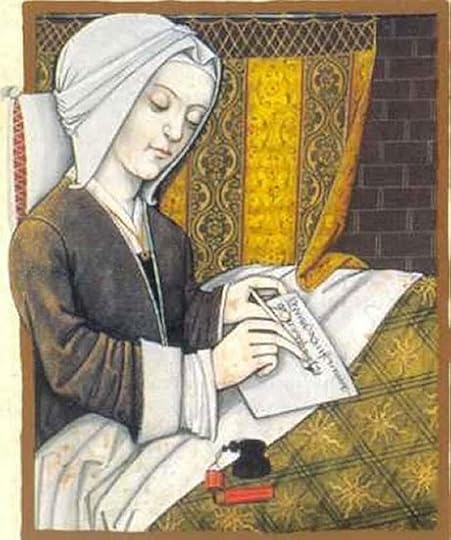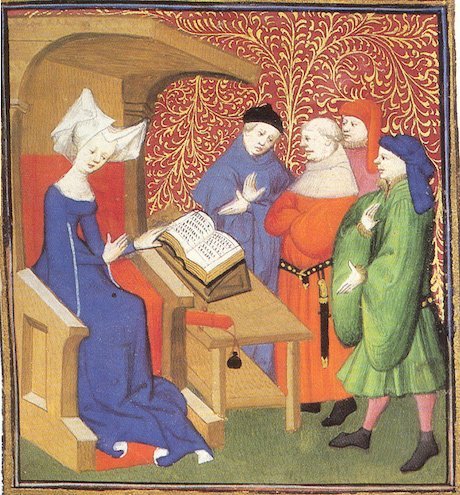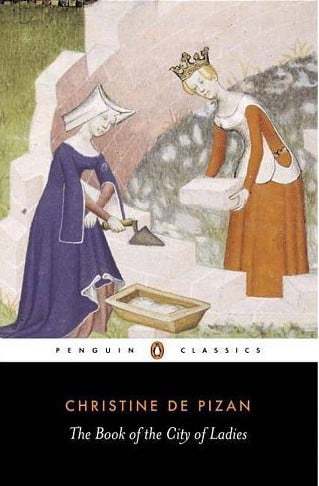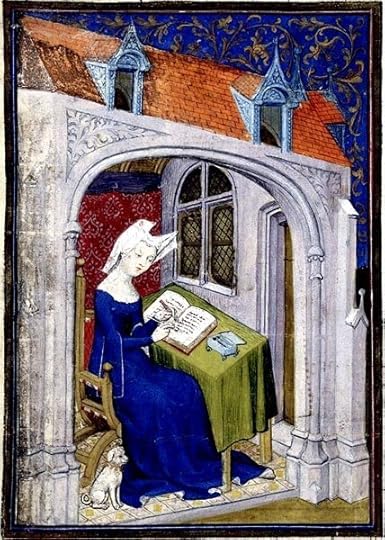Christine de Pizan and The Book of the City of Ladies: An Introduction
Christine de Pizan (1364 – 1430) the French writer, is best known for her seminal work of literature by, about, and in support of women, Le Livre de la Cité des Dames (1405). Now known as The Book of the City of Ladies, it was first translated into English as The Boke of the Cyte of Ladyes and published in London in 1521, “in Paul’s churchyard at the sign of the Trinity by Henry Pepwell.”
This introduction to Christine de Pizan and The Book of the City of Ladies is excerpted fromKilling the Angel: Early Transgressive British Woman Writers by Francis Booth ©2021, reprinted by permission.
Pepwell’s printers in St Paul’s Churchyard published many of the new humanist works along with works of mysticism. In its English version, Christine’s message was well-timed and found a more receptive audience in Tudor Reformation England where printed books in English were leading to greater levels of education among women and creating in turn an appetite for books addressing women in English – Tyndale’s English language New Testament reached England in 1526.
. . . . . . . . .

. . . . . . . . .
“Here beginneth the book of the city of ladies, the which book is divided into three parts. The first part telleth how and by whom the wall and the cloister about the city was made. The second part telleth how and by whom the city was builded within and peopled. The third part telleth how and by whom the high battlements of the towers were perfectly made, and what noble ladies were ordained to dwell in the high palaces and high dungeons.”
Like Julian of Norwich (see more about her in 5 Early English Women Writers to Discover), Christine was a nun who wrote to help women defend themselves against the world of men, though Christine only entered a convent for her own safety later in life after civil war broke out in France; for most of her life she was a professional writer.
. . . . . . . . . .

. . . . . . . . . .
France’s first woman of lettersVirginia Woolf considered Aphra Behn to be the first professional woman writer but Christine, who is considered to be France’s first woman of letters also has a claim to the title. She wasn’t a professional writer in the modern sense of making money from selling books – there would not be any printed books for sale for a long time – her income came from wealthy patrons.
Transgressing the norms of medieval society, Christine wrote treatises on government and public affairs as well as the role of women in society; she also wrote poetry which included much autobiographical information, very unusual in an age when most poets rewrote traditional, impersonal courtly and romantic tales.
The Book of the City of Ladies, was written in response to some of the misogynist works of the time, especially the great mediaeval epic The Romance of the Rose. Christine tells how she a read a book:
“… which made me wonder why on earth it was that so many men, both clerks and others, have said and continue to say and write such awful, damning things about women and their ways. I was at a loss as to how to explain it. It is not just a handful of writers who do this … It is all manner of philosophers, poets and orators too numerous to mention, who all seem to speak with one voice and are unanimous in their view that female nature is wholly given up to vice.”
. . . . . . . . . .

Killing the Angel
on Amazon US*
Killing the Angel
on Amazon UK*
. . . . . . . . .
Christine claims to have had a vision from three ladies, “crowned and of majestic appearance.”They are Reason, Rectitude, and Justice, who have come to help her build a city in which women can live in safety and security. “The female sex has been left defenseless for a long time now, like an orchard without a wall, and bereft of a champion to take up arms in order to protect it.”
“We have come to vanquish from the world the same error into which you had fallen, so that from now on, ladies and all valiant women may have a refuge and defence against the various assailants, those ladies who have been abandoned for so long, exposed like a field without a surrounding hedge, without finding a champion to afford them an adequate defence, notwithstanding those noble men who are required by order of law to protect them, who by negligence and apathy have allowed them to be mistreated.
It is no wonder then that their jealous enemies, those outrageous villains who have assailed them with various weapons, have been victorious in a war in which women have had no defence. Now it is time for their just cause to be taken from Pharaoh’s hands.”
The three ladies tell Christine a large number of stories, which make up the bulk of the book, about famous and admirable women from history in various categories such as learning, invention, poetry, warfare and so on. This is a marvelous and exhaustive catalogue of transgressive, powerful woman from before the Middle Ages. Having built the city with all these exemplary women inhabiting it, Christine invites women to enter it.
“Most excellent, upstanding and worthy princesses of France and other countries, as well as all you ladies, maidens, and women of every estate, you who have ever in the past loved, or do presently love, or who will in the future love virtuous and moral conduct: raise your heads and rejoice in your new city.”
The principal resident of the new city and its supreme monarch will be the Virgin Mary, “she, in her humility, which surpasses that of all other women, coupled with her goodness, which is greater than that even of the angels, will not refuse to live in the City of Ladies. She will reside in the highest palace of all.”
At the age of forty Christine had written at least nineteen books, some of which were on public policy, advocating peace, and addressed to the king and the nobles of France in a transgressive tone which even most men would have been afraid of adopting.
. . . . . . . . . . .

The Book of the City of Ladies on Amazon*
. . . . . . . . . . .
She then wrote a sequel to the Book of the City of Ladies called, confusingly Treasure of the City of Ladies. This is very different from its predecessor, being more of a practical manual for virtuous living; it is almost a religious etiquette manual aimed at princesses and noble women, though it still purports to be inspired by the same three ladies.
“From us three sisters, daughters of God, named Reason, Rectitude and Justice, to all princesses, empresses, queens, duchesses and high-born ladies ruling over the Christian world, and generally to all women: loving greetings.”
More than its predecessor, the book advocates, above all, that women should be faithful to God. Christine addresses all the issues facing wealthy women at all stages of life and constantly advocates modesty, prudence and harmony; she never advocates any form of transgressiveness, despite her own background.
“Do not be proud of yourselves, but always be meek, and by holding to this course you can drive your chariot up to the farthest reaches of glory that Almighty God bestows upon you.”
The nearest she comes to advocating transgression is in relation to a bad husband: although she stresses that a married woman should love her husband, care for him and live in peace with him, not all husbands deserve to be obeyed.
“But some may perhaps answer us here that we are not taking into account certain defects and that we are talking utter nonsense. They may argue that we are saying that come what may ladies ought to love their husbands very much and show the signs of it, but that we are not saying anything about whether they all deserve to be treated so well by their wives.
It is well known that there are some husbands who behave very distantly towards their wives and give no sign of love, or very little. We reply to them that our teaching in this present work is not addressed to men, although some of them need it if they would be well instructed. Because we speak so exclusively to women, we set out for their profit both to teach the valuable methods of avoiding dishonour and to give good advice for following the right course of action.”
. . . . . . . . .

Contributed by Francis Booth,* the author of several books on twentieth-century culture:
Amongst Those Left: The British Experimental Novel 1940-1960 (published by Dalkey Archive); Everybody I Can Think of Ever: Meetings That Made the Avant-Garde; Girls in Bloom: Coming of Age in the Mid-Twentieth Century Woman’s Novel; Text Acts: Twentieth Century Literary Eroticism; and Comrades in Art: Revolutionary Art in America 1926-1938.
Francis has also published several novels: The Code 17 series, set in the Swinging London of the 1960s and featuring aristocratic spy Lady Laura Summers; Young adult fantasy series The Watchers; and Young adult fantasy novel Mirror Mirror. Francis lives on the South Coast of England. He is currently working on High Collars and Monocles: Interwar Novels by Female Couples.
. . . . . . . . . .
*These are Amazon Affiliate links. If a product is purchased by linking through, Literary Ladies Guide receives a modest commission, which helps maintain our site and helps it to continue growing!
The post Christine de Pizan and The Book of the City of Ladies: An Introduction appeared first on Literary Ladies Guide.



